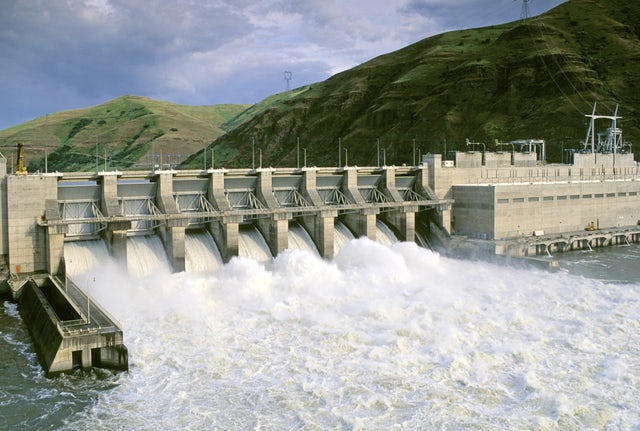forum
library
tutorial
contact

Dam Breaching
Isn't So Simple
by Tom Karier
Spokesman Review, July 12, 2019
|
the film forum library tutorial contact |

|
Dam Breaching
by Tom Karier
|
I expect the future of the four lower Snake River dams to be determined by politics.
 The federal power marketing agency, the Bonneville Power Administration, has characterized its salmon program as the largest recovery effort in the world, and, in fact, it may be. But after billions of dollars spent, salmon recovery continues to elude Bonneville and the question persists: is it time to breach the four lower Snake River dams to save wild salmon?
The federal power marketing agency, the Bonneville Power Administration, has characterized its salmon program as the largest recovery effort in the world, and, in fact, it may be. But after billions of dollars spent, salmon recovery continues to elude Bonneville and the question persists: is it time to breach the four lower Snake River dams to save wild salmon?
Years of campaigning on both sides have painted this as a simple choice: those who favor salmon should support breaching dams and those who favor lower power prices and cheap grain transport should support the dams. During my twenty years representing Washington state on the Northwest Power and Conservation Council, I found the issue far more complex than that. For example, will breaching four dams out of the dozens in the Columbia-Snake River system save salmon, and will breaching increase carbon emissions? These are just two examples of key and difficult questions raised by this policy decision.
Breaching the Snake River dams will result in an immediate loss of more than a thousand average megawatts of carbon-free power. And because they can be turned on and off, they back up hundreds of additional megawatts of wind and solar power, adding a second layer of carbon benefits. Dam breaching advocates have suggested that the lost hydropower should be replaced by energy efficiency and renewables. This is an excellent idea. But until electricity generation in the West is 100% carbon-free, the continued operation of the dams can avoid the release of millions of tons of carbon into the atmosphere every year from gas and coal-fired projects in the West.
What about the fish benefits? Will breaching save salmon? At best, breaching can only help four of the twelve listed salmon species in the Columbia Basin because the others don't migrate through these dams. And one of those four, Snake River Fall chinook, is currently doing well enough that fisherman are allowed to harvest more than 30% of them a year.
The precise impact of the dams on the remaining three species is not a scientific certainty. Unlike other dams that block a quarter of the original salmon habitat, the four Snake River dams do not completely impede salmon passage. Almost all adult salmon successfully pass the dams through fish ladders and only 4 to 12% of juvenile fish currently pass through the turbines on the lower Snake River dams because of screens, bypass systems, spill and other strategies designed to steer them away from power plants. For those 4 to 12% of the juvenile fish that do pass through these turbines, they don't all die. In fact, on average, 90% survive passage through the turbines.
 There is, however, a contrarian theory that claims dams have a much larger delayed effect that is not easily measured and therefore not captured in these survival estimates. If this theory of "delayed mortality" is correct, then breaching would indeed provide more salmon benefits.
There is, however, a contrarian theory that claims dams have a much larger delayed effect that is not easily measured and therefore not captured in these survival estimates. If this theory of "delayed mortality" is correct, then breaching would indeed provide more salmon benefits.
I raise these two questions about carbon impacts and salmon benefits, not because I know the answers but because I think they are important to consider before making a policy decision as important as breaching the four Snake River dams. Fortunately, there is a multimillion-dollar federal study underway evaluating dam breaching and these very questions. This study, the Columbia River System Operations Review, has the resources to review the weight of the evidence for and against the theory of delayed mortality as well as to consider the likely carbon impacts of dam breaching and a multitude of other key questions. Even if federal agencies don't get all of this perfectly correct, they will release their analysis to the public next year so that it can be reviewed by all interested parties, including other technical experts.
I expect the future of the four lower Snake River dams to be determined by politics. But politics won't determine whether it actually saves salmon or adds to climate change. Those are technical issues that will be determined by facts. And because salmon and climate are so important to the Northwest and the planet, the best policy decision on dam breaching has to consider all the facts.
Related Pages:
Why Bonneville Can't Save Salmon by Tom Karier, Spokesman Review, 8/18/19
Two Long-Serving Members of NW Power/ Conservation Council -- Karier, Booth -- Retire by Staff, Columbia Basin Bulletin, 1/11/19
learn more on topics covered in the film
see the video
read the script
learn the songs
discussion forum
